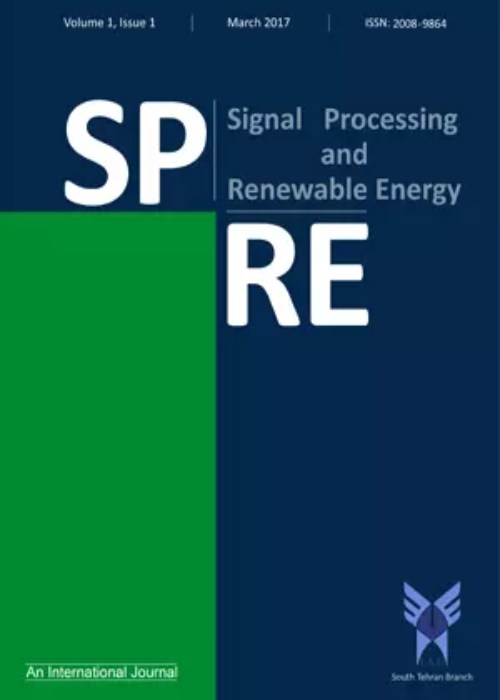فهرست مطالب
Signal Processing and Renewable Energy
Volume:4 Issue: 1, Winter 2020
- تاریخ انتشار: 1398/12/11
- تعداد عناوین: 6
-
Pages 1-21
To ensure the reliable delivery of AC power to consumers from renewable energy sources, the photovoltaic inverter has to ensure that the frequency and magnitude of the generated AC voltage are within acceptable limits. This paper develops models and control strategies for the DC-AC converter to ensure that the sinusoidal waveform of the desired frequency voltage and magnitude generated for both single-phase and three-phase operation depend on the robustness of the inverter control system. The paper reviews various topologies and modulation approaches for photovoltaic inverters in both single-phase and three-phase operational modes. Finally, a proposed control strategy is presented to ensure frequency and voltage regulation.
Keywords: Voltage Regulation, Frequency Regulation, PV Inverter, Harmonic Reduction -
Pages 23-36
This paper explains fault tolerance techniques for Quantum-dot cellular automata which offer remarkable robustness to implement QCA arithmetic circuits. It begins with a study of QCA based design. A classification for fault types is presented and some fault tolerance techniques are examined and their relevance for QCA circuits is evaluated. Finally, it is concluded that a combination of two or more hardware redundancy techniques is needed for tolerating faults in QCA circuits and systems. The proper functionality of the presented design is checked by computer simulations using the QCADesigner tool. Simulation results confirm our claims and their usefulness in designing robust digital circuits.
Keywords: Quantum-dot cellular Automata, Nanoscale circuits, Fault tolerance, Hardware redundancy -
Pages 37-50
The amount of the active power production by the photovoltaic systems depends on the radiation intensity and temperature. In this concept, the optimal use of photovoltaic systems is considered for controlling the voltage and correcting the power factor over day and night. Using this concept, it is possible to use photovoltaic systems in a more optimal way during the day and night. In this method, the photovoltaic systems capacity is not only used during the night to generate reactive power. Although studies have investigated the optimal locating of the distributed generation, DG is referred to as only the source of active power generation. In this paper, a new method for optimal placement of the photovoltaic systems, by considering their inverter nominal capacity to generate reactive power in addition to the active power in order to improve the voltage profile and reduce the system losses of the micro-grid, was employed. Two 33-bus and 6-bus networks were selected for investigating, and after implementing the method as well as applying the genetic algorithm optimization, it was determined that the optimal location of the photovoltaic systems by taking into account the active and reactive power production.
Keywords: Genetic Algorithm, PSO Algorithm, DG resources, Active power, reactive power -
Pages 51-62Movement disorder is one of the common symptoms of Huntington’s disease (HD) that afflicts patients in controlling their movements. The main objective of this paper is to detect abnormal patterns of the foot during gating. The total number of 40 subjects included 16 healthy and 20 HD patients were investigated. All of the subjects were asked to gait in a 70m straight route. The time and time-frequency domain analyses have been used. The support vector machine (SVM) was performed to classify the normal and HD groups. The results showed that using a radial basis function with a combination of time and time-frequency features could better detect the abnormal patterns generated by the motor signal. The classification results for differentiating normal and HD subjects were achieved to the sensitivity and specificity of 93.46% and 91.93%, respectively. This study showed that the proposed algorithm is useful for the early diagnosis of gait pathologies. The results showed accurate performance of this method with the potentials to replace foot sensors signals as a means of classifying gait patterns.Keywords: Motor signals, Huntington’s disease, Feature selection, Classification
-
Pages 63-76
The theory of compressive sensing (CS) in contrast with well-known Nyquist sampling theorem was proposed. Sensing matrix and sparse matrix have key roles in perfect signal reconstruction by using either greedy algorithms like orthogonal matching pursuit (OMP) or -norm based methods. In this paper, different pairs as sensing and sparse matrices are evaluated in terms of randomness and coherence. Noiselet as a complex measurement matrix has low coherence with Haar wavelet, and so the recovered images by OMP in comparison with other measurement-sparse matrices are appropriate. But, because of complexity, it cannot be used for big size images. However, the pair structured random sensing matrix with values 0, 1 and Fourier sparse matrix which got the second rank in terms of coherence, approved to be a noise robust pair and showed a great potential to be used in CS.
Keywords: coherence, Compressive sensing (CS), Noise Robust, Noiselets, randomness -
Pages 77-88
Extraction of blood vessels in retinal images is helpful for ophthalmologists to screen a large number of medical disorders. The changes in the retinal vessels due to pathologies can be easily identified by the retinal vessel segmentation. Therefore, in this paper, we propose an automatic method to extract the blood vessels from various normal and abnormal retinal images. Our proposed method uses the advantages of the optimal Gabor filter and morphological reconstruction to employ robust performance analysis to evaluate the accuracy and sensitivity. Moreover, unsharp filter is used which sharpens the edges of the vessels without increasing noise. Our proposed algorithm proves its better performance by achieving the greatest accuracy, sensitivity, and specificity for the DRIVE and the STARE databases respectively. The results illustrate the superior performance of the proposed algorithm when they compared to other existing vessel segmentation methods.
Keywords: Retinal images, Optimized Gabor filter, Morphological reconstruction, Unsharp Filter


